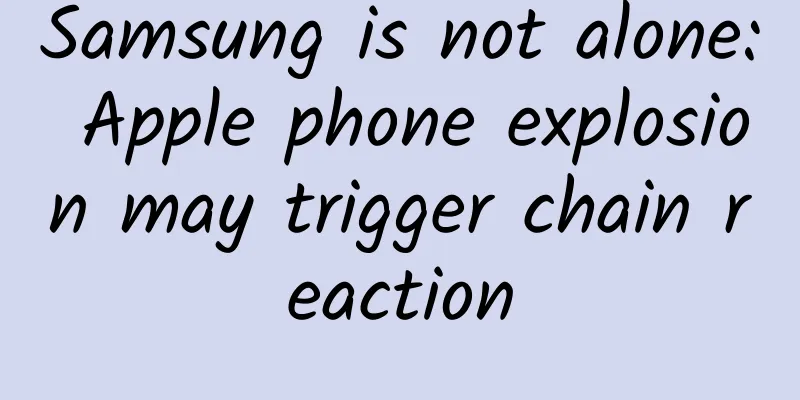Samsung is not alone: Apple phone explosion may trigger chain reaction

|
Throughout September, the explosion of Samsung Note7 was the news in the IT industry. From the explosion in South Korea to the multiple explosions in the United States, and then the four explosions in China, Samsung, which resolutely refused to recall the product in China, was pushed to the forefront. The long holiday on October 1 was a respite for Samsung, and during this period, news of iPhone explosions came from the United States. First, the American media ABC reported that a student's iPhone 6 Plus caught fire in his trouser pocket; then the American ABC 30 reported that a California woman's iPhone 6 Plus suddenly exploded while charging at night, and the items and furniture near the dressing table were damaged; then a netizen on the American Reddit forum website broke the news that he had pre-ordered an iPhone 7 Plus and it was also burnt in the box. This situation is very similar to the situation faced by Samsung a month ago. The explosion of Samsung Note 7 made iPhone 7 the biggest beneficiary, and now iPhone 7 has also exploded. How will this incident develop? What impact will it have on the mobile phone market? 1. The explosion of mobile phone lithium batteries cannot be prevented All mobile phone fires and explosions are caused by battery problems. Almost all mobile phone batteries now use lithium-ion batteries. Lithium is a very active metal. Due to its chemical properties, batteries with high capacity density have been developed. However, the active chemical properties of lithium can also bring dangers. When lithium metal is exposed to air, it will produce a violent oxidation reaction with oxygen and explode. In order to improve safety, scientists have invented materials such as graphite and lithium cobalt oxide to store lithium. The molecular structure of these materials forms nanoscale storage grids that can be used to store lithium atoms. In this way, even if the battery shell is broken and oxygen enters, the lithium atoms will not come into contact with oxygen and react, because the oxygen molecules are too large to enter these tiny storage grids, thus avoiding explosion. When a lithium-ion battery is charged, the lithium atoms at the positive electrode lose electrons and become lithium ions. The lithium ions travel to the negative electrode through the electrolyte (or polymer), enter the storage cell of the negative electrode, and gain an electron, reducing to lithium atoms. When discharging, the whole process is reversed. A diaphragm with many pores is added to the battery to prevent short circuits. A good diaphragm can also automatically close the pores when the battery temperature is too high, preventing lithium ions from passing through and preventing danger. However, in actual use, when an external short circuit occurs, the battery temperature will rise sharply, causing the electrolyte to vaporize (the polymer will expand), bursting the battery shell, and the lithium will catch fire when it encounters oxygen in the air. If there is no external short circuit, but the battery is not manufactured carefully enough and small impurities penetrate the diaphragm paper, causing an internal short circuit, fire and explosion may occur when the problem is serious. If there is no problem with the battery quality, but the battery is overcharged. In the case of overcharge, the negative electrode will produce a lot of needle-shaped lithium metal crystals, these crystals will also pierce the diaphragm paper, causing an internal short circuit, and thus fire and explosion. In addition, high temperature, impact, and puncture may damage the diaphragm. In the case of an internal short circuit, the problem often occurs suddenly. Due to quality problems or improper use, a short circuit has occurred inside the battery, but the heat of the battery is slowly accumulating and you cannot detect it. When the heat accumulates to a certain extent, the short circuit is serious and reaches a critical point, it will cause the phone to catch fire or explode without any warning. Therefore, lithium batteries are not 100% safe. Problems in manufacturing quality control, external short circuits, high temperatures, impacts, punctures, and overcharging can all cause dangers. Even if lithium batteries are inspected before leaving the factory, they are still prone to hidden damage and dangers during daily use. Whether it is Samsung, Apple, Huawei or Xiaomi, they have no ability to solve the inherent defects of lithium batteries and can only reduce the probability of occurrence as much as possible. Batch and Occasional Problems Samsung's large-scale recall of Note7 is not due to improper use by users, but Samsung's own investigation found that there is a problem with its own SDI battery. (Whether this investigation is comprehensive remains to be verified). This is a quality problem in the product batch. Even if the user does not use it improperly, without high temperature, impact, puncture, or overcharging, there is a certain probability that the product will inexplicably burn and explode, so Samsung must recall it. Samsung refused to recall the products, saying that the batch had no system problems and was caused by normal quality control errors and improper daily use. Although there have been several incidents with iPhone 6 and iPhone 7, there has been no credible investigation to prove that it was a batch problem, so there is no need for Apple to recall a large number of them. Apple’s previous generation of products also had multiple explosion problems, which even triggered an investigation by the European Union, but Apple did not recall them. In fact, if you search for any brand of mobile phone, you will find news about battery combustion and explosion. The technical problems of lithium batteries are not something that mobile phone manufacturers can solve. However, as people's requirements for battery capacity become higher and higher, coupled with the demand for fast charging, the probability of dangerous occasional problems is increasing. The lower the battery capacity density, the safer it is. The higher the density, the higher the risk. In order to increase the volume and power, today's batteries are desperately trying to increase their energy density, which makes today's batteries dangerous. In addition, the rise of fast charging has also increased the risk. First, fast charging is inherently dangerous. Second, the high temperatures of circuits and chips caused by fast charging will add unnecessary external risks to the battery. Therefore, although the batch problem of lithium batteries is an isolated case, overall the risk probability is indeed higher than before. 3. Will it trigger a chain reaction? It is inevitable that lithium batteries will have problems with a small probability, but it is not inevitable that such problems will attract public attention. Communication is a very interesting thing. Before the recall of Samsung Note7, problems with Apple products would not cause much concern. The continuous explosions in France were investigated by the European Union. But when the media focused on this focus, any problem would be magnified under the media magnifying glass. Today it is the Apple iPhone 7, tomorrow it will be other brands, because problems are bound to happen. When the media pays attention, things that were easily overlooked and covered up before will be dug out. Even if the manufacturer does some public relations, competitors will not miss the opportunity, and consumers will be happy to report problems with their phones to the media. If there was no recall of Samsung Note7, the explosion of licensed Note7 would only be handled by Samsung itself, and users would post on forums, but the media would not be interested. But with the recall, the four explosions became known to the world. As this effect continues, the explosion of iPhone 7 has become known to the world, and it is estimated that there will be follow-up news in the future. During this period, if other brands of mobile phones unfortunately encounter problems, then the next brand will continue to have a series of explosive news events, forming a chain reaction. The entire incident died down naturally until the media decided that the explosion of mobile phones was not news and could not attract attention. For users, the safety of lithium batteries is limited, and consumers cannot control it from the manufacturer's end. However, when using it yourself, you can be careful not to hit it, do not expose the phone to high temperatures, do not overcharge it, reduce the number of fast charges, and pay attention to the temperature of the phone. Absolute safety cannot be guaranteed, but being careful during use can at least reduce the probability of problems and ensure your own safety. As a winner of Toutiao's Qingyun Plan and Baijiahao's Bai+ Plan, the 2019 Baidu Digital Author of the Year, the Baijiahao's Most Popular Author in the Technology Field, the 2019 Sogou Technology and Culture Author, and the 2021 Baijiahao Quarterly Influential Creator, he has won many awards, including the 2013 Sohu Best Industry Media Person, the 2015 China New Media Entrepreneurship Competition Beijing Third Place, the 2015 Guangmang Experience Award, the 2015 China New Media Entrepreneurship Competition Finals Third Place, and the 2018 Baidu Dynamic Annual Powerful Celebrity. |
>>: What should we do when entrepreneurial blind spots appear frequently?
Recommend
A good function! Detailed experience of the love mode on the 12306 website
[[421835]] 12306 has launched the Love Mode, whic...
We analyzed 100 mobile apps and found 6 common reasons why apps crash!
People hate app crashes, especially when they slo...
Introduction to the process of 4 common marketing promotion methods
Previously we talked about some core work ideas o...
HTML5 is here, 7 hybrid mobile development frameworks
via: Geek Label It is the best time to start lear...
Science illustrations | Tribute to the pioneers of science and technology development in New China
...
2-Minute Coding Tip: Don't Use Loops in Your Code
Instead of writing for or while loops, you should...
The Death of X86 Mobile Phones: Falling Behind at the Starting Line
Intel will significantly reduce its investment in...
Sina Weibo's nine-square grid, you say it's not good before you even understand it?
CPs are all familiar with the nine-square grid on...
In fact, everyone is "love-brained"?
Love is sweet and makes people yearn for it, but ...
iOS 11 installation rate has reached 59%, but it is lower than iOS 10 during the same period
On December 6, according to foreign media reports...
A dose of science | Is that you? Research finds that people with stronger immunity have higher "appearance"
"Wow, your immunity is so strong... The moon...
National Hypertension Day | You must not know these 5 misunderstandings about lowering blood pressure
Hypertension is the most important risk factor fo...
Coca-Cola Marketing Law!
When you see this billboard, can you recognize wh...
Price inquiry for the production of Quzhou Mall Mini Program. How much does it cost to produce Quzhou Mall Mini Program?
How much does it cost to produce the Quzhou Mall ...
Xu Wenjie, the practical methodology of the champion short-term trader
: : : : : : : : : : : : : : :...









